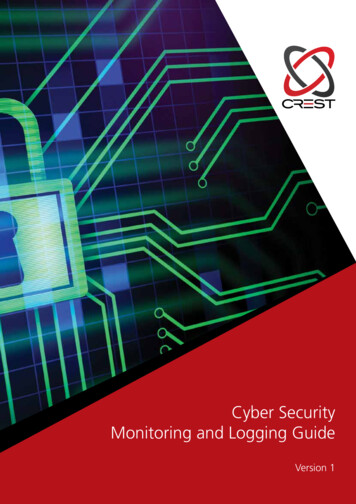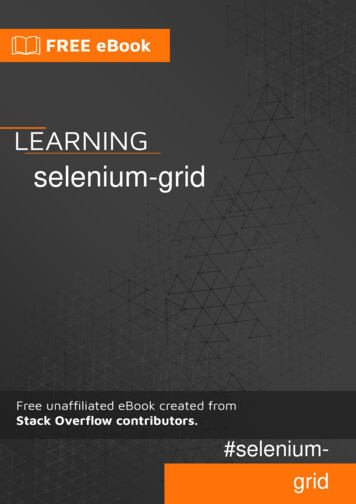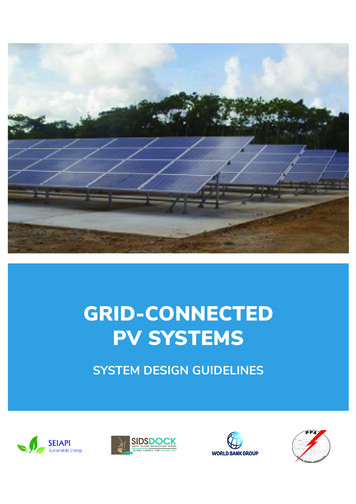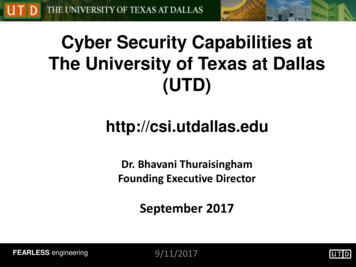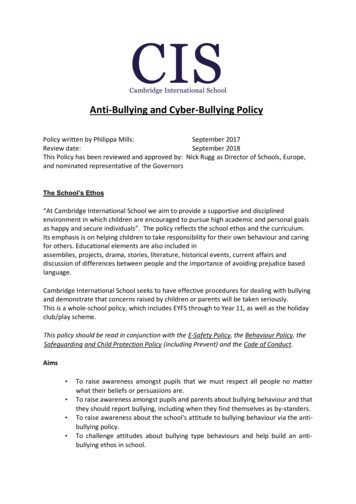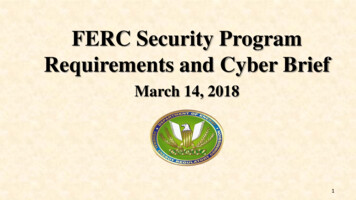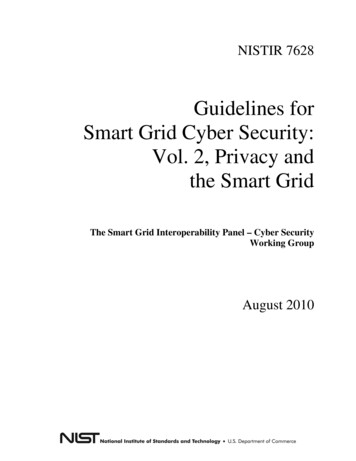
Transcription
NISTIR 7628Guidelines forSmart Grid Cyber Security:Vol. 2, Privacy andthe Smart GridThe Smart Grid Interoperability Panel – Cyber SecurityWorking GroupAugust 2010
NISTIR 7628Guidelines forSmart Grid Cyber Security:Vol. 2, Privacy andthe Smart GridThe Smart Grid Interoperability Panel–Cyber Security Working GroupAugust 2010U. S. Department of CommerceGary Locke, SecretaryNational Institute of Standards and TechnologyPatrick D. Gallagher, Director
REPORTS ON COMPUTER SYSTEMS TECHNOLOGYThe Information Technology Laboratory (ITL) at the National Institute of Standards andTechnology (NIST) promotes the U.S. economy and public welfare by providing technicalleadership for the Nation’s measurement and standards infrastructure. ITL develops tests, testmethods, reference data, proof of concept implementations, and technical analysis to advance thedevelopment and productive use of information technology (IT). ITL’s responsibilities includethe development of technical, physical, administrative, and management standards andguidelines for the cost-effective security and privacy of sensitive unclassified information infederal computer systems. This National Institute of Standards and Technology InteragencyReport (NISTIR) discusses ITL’s research, guidance, and outreach efforts in computer securityand its collaborative activities with industry, government, and academic organizations.National Institute of Standards and Technology Interagency Report 7628, vol. 269 pages (August 2010)Certain commercial entities, equipment, or materials may be identified in thisreport in order to describe an experimental procedure or concept adequately.Such identification is not intended to imply recommendation or endorsement bythe National Institute of Standards and Technology, nor is it intended to implythat the entities, materials, or equipment are necessarily the best available for thepurpose.
ACKNOWLEDGMENTSThis report was developed by members of the Smart Grid Interoperability Panel–Cyber SecurityWorking Group (SGIP-CSWG), formerly the Cyber Security Coordination Task Group(CSCTG), and during its development was chaired by Annabelle Lee of the Federal EnergyRegulatory Commission (FERC), formerly of NIST. The CSWG is now chaired by MarianneSwanson (NIST). Alan Greenberg (Boeing), Dave Dalva (CiscoSystems), and Bill Hunteman(Department of Energy) are the vice chairs. Mark Enstrom (Neustar) is the secretary. TanyaBrewer of NIST is the lead editor of this report. The members of the SGIP-CSWG haveextensive technical expertise and knowledge to address the cyber security needs of the SmartGrid. The dedication and commitment of all these individuals over the past year and a half issignificant. In addition, appreciation is extended to the various organizations that havecommitted these resources to supporting this endeavor. Members of the SGIP-CSWG and theworking groups of the SGIP-CSWG are listed in Appendix J of this report.In addition, acknowledgement is extended to the NIST Smart Grid Team, consisting of staff inthe NIST Smart Grid Office and several of NIST’s Laboratories. Under the leadership of Dr.George Arnold, National Coordinator for Smart Grid Interoperability, their ongoing contributionand support of the CSWG efforts have been instrumental to the success of this report.Additional thanks are extended to Diana Johnson (Boeing) and Liz Lennon (NIST) for theirsuperb technical editing of this report. Their expertise, patience, and dedication were critical inproducing a quality report. Thanks are also extended to Victoria Yan (Booz Allen Hamilton).Her enthusiasm and willingness to jump in with both feet are really appreciated.Finally, acknowledgment is extended to all the other individuals who have contributed their timeand knowledge to ensure this report addresses the security needs of the Smart Grid.
TABLE OF CONTENTSOVERVIEW AND REPORT ORGANIZATION . VIReport Overview . viAudience. viContent of the Report . viCHAPTER FIVE PRIVACY AND THE SMART GRID . 1Chapter Abstract. 15.1 Introduction. 35.2 What Is Privacy? . 55.3 Legal Frameworks and Considerations. 75.4 Consumer-to-Utility Privacy Impact Assessment . 155.5 Personal Information in the Smart Grid . 245.6 In-depth Look at Smart Grid Privacy Concerns. 275.7 Mitigating Privacy Concerns Within the Smart Grid. 375.8 Smart Grid Privacy Summary And Recommendations. 39APPENDIX C STATE LAWS – SMART GRID AND ELECTRICITY DELIVERY REGULATIONS. C-1APPENDIX D PRIVACY USES CASES . D-1D.1D.2D.3D.4D.5Use Case Inventory, Consolidation and Gap Analysis. D-1Incorporating Privacy Into Existing Smart Grid Use Cases. D-2Privacy Use Case Examples. D-3Privacy Use Case #1: Landlord with Tenants . D-4Privacy Use Case #2: PEV General Registration and Enrollment Process . D-8APPENDIX E PRIVACY RELATED DEFINITIONS . E-1E.1E.2E.3E.4E.5E.6E.7E.8Privacy Impact Assessment .E-1Personal Information.E-1Personally Identifiable Information (PII).E-2Composite Personal Information .E-3Private Information .E-3Confidential Information .E-3Individual .E-4Smart Grid Entity.E-4LIST OF FIGURESFigure 5-1 Power Usage to Personal Activity Mapping . 13Figure 5-2 NIST Conceptual Model . 15LIST OF TABLESTable 5-1 Information potentially available through the Smart Grid . 26Table 5-2 Potential Privacy Concerns and Descriptions. 28Table 5-3 Potential Privacy Impacts that Arise from the Collection and Use of SmartGrid Data. 30v
NISTIR 7628 Guidelines for Smart Grid Cyber Security v1.0 – Aug 2010OVERVIEW AND REPORT ORGANIZATIONREPORT OVERVIEWVersion 1.0 (V1.0) of NIST Interagency Report (NISTIR) 7628, Guidelines for Smart GridCyber Security, is the Smart Grid Interoperability Panel—Cyber Security Working Group’s(SGIP-CSWG’s) report for individuals and organizations who will be addressing cyber securityfor Smart Grid systems. This includes, for example, vendors, manufacturers, utilities, systemoperators, researchers, and network specialists; and individuals and organizations representingthe IT, telecommunications, and electric sectors. This report assumes readers have a functionalknowledge of the electric sector and a functional understanding of cyber security.AUDIENCEThis report is intended for a variety of organizations that may have overlapping and differentperspectives and objectives for the Smart Grid. For example— Utilities/asset owners/service providers may use this report as guidance for a specificSmart Grid information system implementation; Industry/Smart Grid vendors may base product design and development, andimplementation techniques on the guidance included in this report; Academia may identify research and development topics based on gaps in technical areasrelated to the functional, reliability, security, and scalability requirements of the SmartGrid; and Regulators/policy makers may use this report as guidance to inform decisions andpositions, ensuring that they are aligned with appropriate power system and cybersecurity needs.CONTENT OF THE REPORT Volume 1 – Smart Grid Cyber Security Strategy, Architecture, and High-LevelRequirements– Chapter 1 – Cyber Security Strategy includes background information on the SmartGrid and the importance of cyber security in ensuring the reliability of the grid andthe confidentiality of specific information. It also discusses the cyber security strategyfor the Smart Grid and the specific tasks within this strategy.– Chapter 2 – Logical Architecture includes a high level diagram that depicts acomposite high level view of the actors within each of the Smart Grid domains andincludes an overall logical reference model of the Smart Grid, including all the majordomains. The chapter also includes individual diagrams for each of the 22 logicalinterface categories. This architecture focuses on a short-term view (1–3 years) of theSmart Grid.– Chapter 3 – High Level Security Requirements specifies the high level securityrequirements for the Smart Grid for each of the 22 logical interface categoriesincluded in Chapter 2.vi
NISTIR 7628 Guidelines for Smart Grid Cyber Security v1.0 – Aug 2010– Chapter 4 – Cryptography and Key Management identifies technical cryptographicand key management issues across the scope of systems and devices found in theSmart Grid along with potential alternatives.– Appendix A – Crosswalk of Cyber Security Documents– Appendix B – Example Security Technologies and Procedures to Meet the High LevelSecurity Requirements Volume 2 – Privacy and the Smart Grid– Chapter 5 – Privacy and the Smart Grid includes a privacy impact assessment for theSmart Grid with a discussion of mitigating factors. The chapter also identifiespotential privacy issues that may occur as new capabilities are included in the SmartGrid.– Appendix C – State Laws – Smart Grid and Electricity Delivery– Appendix D – Privacy Use Cases– Appendix E – Privacy Related Definitions Volume 3 – Supportive Analyses and References– Chapter 6 – Vulnerability Classes includes classes of potential vulnerabilities for theSmart Grid. Individual vulnerabilities are classified by category.– Chapter 7 – Bottom-Up Security Analysis of the Smart Grid identifies a number ofspecific security problems in the Smart Grid. Currently, these security problems donot have specific solutions.– Chapter 8 – Research and Development Themes for Cyber Security in the Smart Gridincludes R&D themes that identify where the state of the art falls short of meeting theenvisioned functional, reliability, and scalability requirements of the Smart Grid.– Chapter 9 – Overview of the Standards Review includes an overview of the processthat is being used to assess standards against the high level security requirementsincluded in this report.– Chapter 10 – Key Power System Use Cases for Security Requirements identifies keyuse cases that are architecturally significant with respect to security requirements forthe Smart Grid.– Appendix F – Logical Architecture and Interfaces of the Smart Grid– Appendix G – Analysis Matrix of Interface Categories– Appendix H – Mappings to the High Level Security Requirements– Appendix I – Glossary and Acronyms– Appendix J – SGIP-CSWG Membershipvii
NISTIR 7628 Guidelines for Smart Grid Cyber Security v1.0 – Aug 2010CHAPTER FIVEPRIVACY AND THE SMART GRIDThe Smart Grid is an evolving construct of new technologies, services, and entitiesintegrating with legacy solutions and organizations. The SGIP-CSWG privacy subgroupviews the privacy chapter as a starting point for continuing the work to improve upon privacypractices as the Smart Grid continues to evolve and as new privacy threats, vulnerabilitiesand the associated risks emerge. The information in this chapter was developed as aconsensus document by a diverse subgroup consisting of representatives from the privacy,electric energy, telecommunications and cyber industry, academia, and governmentorganizations. The chapter does not represent legal opinions, but rather was developed toexplore privacy concerns, and provide associated recommendations for addressing them.Privacy impacts and implications may change as the Smart Grid expands and matures. Itshould be noted that this chapter addresses residential users and their data. The CSWGPrivacy Subgroup will begin to explore privacy concerns for commercial, industrial, andinstitutional energy consumers, and deliver updates to existing work to address any newprivacy considerations based on the pace of Smart Grid evolution.CHAPTER ABSTRACTThe Smart Grid brings with it many new data collection, communication, and informationsharing capabilities related to energy usage, and these technologies in turn introduce concernsabout privacy. Privacy relates to individuals. Four dimensions of privacy are considered: (1)personal information— any information relating to an individual, who can be identified,directly or indirectly, by that information and in particular by reference to an identificationnumber or to one or more factors specific to his or her physical, physiological, mental,economic, cultural, locational or social identity; (2) personal privacy—the right to control theintegrity of one’s own body; (3) behavioral privacy—the right of individuals to make theirown choices about what they do and to keep certain personal behaviors from being sharedwith others; and (4) personal communications privacy—the right to communicate withoutundue surveillance, monitoring, or censorship.Most Smart Grid entities directly address the first dimension, because privacy of personalinformation is what most data protection laws and regulations cover. However, the otherthree dimensions are important privacy considerations as well and should be considered bySmart Grid entities.When considering how existing laws may deal with privacy issues within the Smart Grid, andlikewise the potential influence of other laws that explicitly apply to the Smart Grid, it isimportant to note that while Smart Grid privacy concerns may not be expressly addressed,existing laws and regulations may still be applicable. Nevertheless, the innovativetechnologies of the Smart Grid pose new issues for protecting consumers’ privacy that willhave to be tackled by law or by other means.1
NISTIR 7628 Guidelines for Smart Grid Cyber Security v1.0 – Aug 2010The Smart Grid will greatly expand the amount of data that can be monitored, collected,aggregated, and analyzed. This expanded information, particularly from energy consumersand other individuals, raises added privacy concerns. For example, specific appliances andgenerators can be identified from the signatures they exhibit in electric information at themeter when collections occur with great frequency as opposed to through traditional monthlymeter readings. This more detailed information expands the possibility of intruding onconsumers’ and other individuals’ privacy expectations.The research behind the material presented in this chapter focused on privacy within personaldwellings and electric vehicles and did not address business premises and the privacy ofindividuals within such premises. The researchers’ conclusions based upon work in theseprimary areas are as follows: Evolving Smart Grid technologies and associated new types of information related toindividuals, groups of individuals, and their behavior within their premises andelectric vehicles privacy risks and challenges that have not been tested and may ormay not be mitigated by existing laws and regulations. New Smart Grid technologies, and particularly smart meters, smart appliances, andsimilar types of endpoints, create new privacy risks and concerns that may not beaddressed adequately by the existing business policies and practices of utilities andthird-party Smart Grid providers. Utilities and third-party Smart Grid providers need to follow standard privacy andinformation security practices to effectively and consistently safeguard the privacy ofpersonal information. Most consumers probably do not understand their privacy exposures or their optionsfor mitigating those exposures within the Smart Grid.Based on initial research and the details of the associated findings, a summary listing of allrecommendations includes the following points for entities that participate within the SmartGrid: Conduct pre-installation processes and activities for using Smart Grid technologieswith utmost transparency. Conduct an initial privacy impact assessment before making the decision to deployand/or participate in the Smart Grid. Additional privacy impact assessments should beconducted following significant organizational, systems, applications, or legalchanges—and particularly, following privacy breaches and information securityincidents involving personal information, as an alternative, or in addition, to anindependent audit. Develop and document privacy policies and practices that are drawn from the full setof Organisation for Economic Cooperation and Development (OECD) PrivacyPrinciples and other authorities (see 5.4.1 “Consumer-to-Utility PIA Basis andMethodology”). This should include appointing personnel responsible for ensuring2
NISTIR 7628 Guidelines for Smart Grid Cyber Security v1.0 – Aug 2010privacy policies and protections are implemented. Provide regular privacy training and ongoing awareness communications andactivities to all workers who have access to personal information within the SmartGrid. Develop privacy use cases that track data flows containing personal information toaddress and mitigate common privacy risks that exist for business processes withinthe Smart Grid. Educate consumers and other individuals about the privacy risks within the SmartGrid and what they can do to mitigate them. Share information with other Smart Grid market participants concerning solutions tocommon privacy-related risks.Additionally, manufacturers and vendors of smart meters, smart appliances, and other typesof smart devices, should engineer these devices to collect only the data necessary for thepurposes of the smart device operations. The defaults for the collected data should beestablished to use and share the data only as necessary to allow the device to function asadvertised and for the purpose(s) agreed to by Smart Grid consumers.5.1 INTRODUCTIONModernizing the current electric grid through the computerization and networking of intelligentcomponents holds the promise of a Smart Grid infrastructure that can— Deliver electricity more efficiently; Provide better power quality; Link with a wide array of energy sources in addition to energy produced by power plants(such as renewable energy sources); Enable self-healing in cases of disturbance, physical and cyber attack, or natural disaster;and Provide consumers, and other individuals 1 , with more choices based on how, when, andhow much electricity they use.Communications technology that enables the bidirectional flow of information throughout theinfrastructure is at the core of these Smart Grid improvements, which rely upon collated energyusage data provided by smart meters, sensors, computer systems, and many other devices to1Because consumers are often thought of as the individuals who actually pay the energy bills, the SGIP-CSWGprivacy group determined it was important to include reference all individuals who would be within a particulardwelling or location since their activities could also be determined in the ways described within this chapter. Fromthis point forward, for brevity, only the term “consumers” will be used, but it will mean all the individualsapplicable to the situation being described.3
NISTIR 7628 Guidelines for Smart Grid Cyber Security v1.0 – Aug 2010derive understandable and actionable information for consumers and utilities—and it is thissame technology that also brings with it an array of privacy challenges. The granularity, or depthand breadth of detail, captured in the information collected and the interconnections created bythe Smart Grid are factors that contribute most to these new privacy concerns.The Smart Grid Interoperability Panel–Cyber Security Working Group (SGIP-CSWG)has worked since June 2009 to research privacy issues within the existing and planned SmartGrid environment. Its research to date has focused on privacy concerns related to consumers’personal dwellings and use of electric vehicles. 2 In July and August of 2009, the privacysubgroup performed a comprehensive privacy impact assessment (PIA) for the consumer-toutility portion of the Smart Grid, and the results of this study have enabled the group to make therecommendations found in this chapter for managing the identified privacy risks.The privacy subgroup membership is derived from a wide range of organizations and industries,including utilities, state utility commissions, privacy advocacy groups, academia, Smart Gridappliance and applications vendors, information technology (IT) engineers, and informationsecurity (IS) practitioners. This diversity of disciplines and areas of interest among the group’sparticipants helps to ensure all viewpoints are considered when looking at privacy issues, and itbrought a breadth of expertise both in recognizing inherent privacy risk areas and in identifyingfeasible ways in which those risks might be mitigated while at the same time supporting andmaintaining the value and benefits of the Smart Grid.Because this chapter will be read by individuals with a wide range of interests, professionalfields, and levels of expertise with respect to Smart Grid privacy issues, careful consideration hasbeen given to the chapter’s structure, which is as follows:1. Discussion of the concept of privacy. This establishes our common ground inunderstanding the notion of “privacy,” and defines the notion of privacy, where readersmay hold different viewpoints on the subject.2. Definitions of privacy terms. Privacy terms are defined differently among variousindustries, groups, countries, and even individuals. We define the privacy terms used inthis chapter.3. Overview of current data protection laws and regulations with respect to privacy.Even though numerous laws exist to establish a range of privacy protections, it isimportant to consider how those privacy protections apply to the Smart Grid.4. Determination of personal activities within the Smart Grid. This explains the creationof new data types in the Smart Grid, as well as new uses for data that has formerly onlybeen in the possession of utilities outside of retail access states. 32There may also be privacy concerns for individuals within business premises, such as hotels, hospitals, and officebuildings, in addition to privacy concerns for transmitting Smart Grid data across country borders. However,because the existing collection of NIST use cases does not cover business locations or cross border datatransmission, and in view of its time constraints, the Privacy Group did not research business premises or crossborder privacy issues. The Privacy Group recommends these as topics for further investigation.3“Retail access states” refers to those states offering programs whereby energy services companies may supplyservice to customers at market-based prices.4
NISTIR 7628 Guidelines for Smart Grid Cyber Security v1.0 – Aug 20105. Summary of the consumer-to-utility PIA. Identifies key privacy issues identified by theprivacy subgroup in performing its PIA for the consumer-to-utility portion of the SmartGrid and provides a guide for subsequent research.6. In-depth look at privacy issues and concerns. Addresses follow-on research based onthe PIA findings in which the privacy subgroup explored the broader privacy issues thatexist within the entire expanse of the Smart Grid.7. Detailed analysis of representative privacy use cases. Use cases can help Smart Gridarchitects and engineers build privacy protections into the Smart Grid. Some exampleprivacy use cases were created for specific scenarios within the Smart Grid to identifyprivacy concerns and demonstrate how to use privacy use cases. Developers of SmartGrid applications, systems, and operational processes can employ a more comprehensiveset of privacy use cases to create architectures that build in privacy protections to mitigateidentified privacy risks.8. Conclusions and recommendations. This section summarizes the main points andfindings on the subject of privacy and collects in one place all of the recommendationsfound within this Privacy Chapter.9. Appendices. Reference material.5.2 WHAT IS PRIVACY?There is no one universal, internationally accepted definition of “privacy,” it can mean manythings to different individuals. At its most basic, privacy can be seen as the right to be left alone. 4Privacy is not a plainly delineated concept and is not simply the specifications provided withinlaws and regulations. Furthermore, privacy should not be confused, as it often is, with being thesame as confidentiality; and personal information 5 is not the same as confidential information.Confidential information 6 is information for which access should be limited to only those with abusiness need to know and that could result in compromise to a system, data, application, orother business function if inappropriately shared. 7It is important to understand that privacy considerations with respect to the Smart Grid includeexamining the rights, values, and interests of individuals; it involves the related characteristics,descriptive information and labels, activities, and opinions of individuals, to name just a fewapplicable considerations.For example, some have described privacy as consisting of four dimensions: 84Warren, Samuel D. and Louis D. Brandeis “The Right to Privacy,” Harvard Law Review, Vol. IV December 15,1890 No. 55See a full definition and discussion of “personal information” in Appendix C.6The use of the phrase “confidential information” in this document does not refer to National Security/classifiedinformation.7For example, market data that does not include customer-specific details is considered confidential. Other chapterswithin this report address confidentiality in depth.8See Roger Clarke, "What’s Privacy?" at http://www.rogerclarke.com/DV/Privacy.html. Clarke makes a similar setof distinctions between the privacy of the physical person, the privacy of personal behavior, the privacy of personal5
NISTIR 7628 Guidelines for Smart Grid Cyber Security v1.0 – Aug 20101. Privacy of personal information. This is the most commonly thought-of dimension.Personal information is any information relating to an individual, who can be identified,directly or indirectly, by that information and in particular by reference to anidentification number or to one or more factors specific to his or her physical,physiological, mental, economic, cultural, locational or social identity. Privacy ofpersonal information involves the right to control when, where, how, to whom, and towhat extent an individual shares their own personal information, as well as the right toaccess personal information given to others, to correct it, and to ensure it is safeguardedand disposed of appropriately.2. Privacy of the person. This is the right to control the integrity of one’s own body. Itcovers such things as physical requirements, health problems, and required medicaldevices.3. Privacy of personal behavior. This is the right of individuals to keep any knowledge oftheir activities, and their choices, from being shared with others.4. Privacy of personal communications. This is the right to communicate without unduesurveillanc
In addition, acknowledgement is extended to the NIST Smart Grid Team, consisting of staff in the NIST Smart Grid Office and several of NIST’s Laboratories. Under the leadership of Dr. George Arnold, National Coordinator for Smart


